Related Research Articles
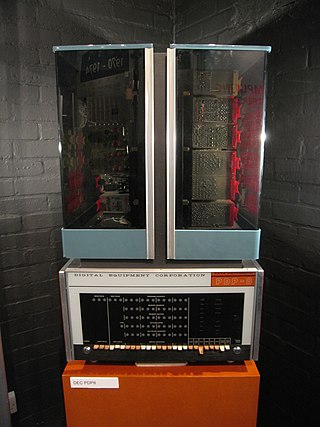
The PDP-8 is a family of 12-bit minicomputers that was produced by Digital Equipment Corporation (DEC). It was the first commercially successful minicomputer, with over 50,000 units being sold over the model's lifetime. Its basic design follows the pioneering LINC but has a smaller instruction set, which is an expanded version of the PDP-5 instruction set. Similar machines from DEC are the PDP-12 which is a modernized version of the PDP-8 and LINC concepts, and the PDP-14 industrial controller system.
TECO, short for Text Editor & Corrector, is both a character-oriented text editor and a programming language, that was developed in 1962 for use on Digital Equipment Corporation computers, and has since become available on PCs and Unix. Dan Murphy developed TECO while a student at the Massachusetts Institute of Technology (MIT).

RSX-11 is a discontinued family of multi-user real-time operating systems for PDP-11 computers created by Digital Equipment Corporation. In widespread use through the late 1970s and early 1980s, RSX-11 was influential in the development of later operating systems such as VMS and Windows NT.
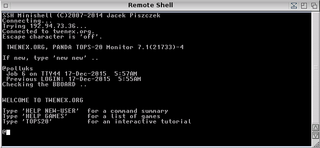
The TOPS-20 operating system by Digital Equipment Corporation (DEC) is a proprietary OS used on some of DEC's 36-bit mainframe computers. The Hardware Reference Manual was described as for "DECsystem-10/DECSYSTEM-20 Processor".
RT-11 is a discontinued small, low-end, single-user real-time operating system for the full line of Digital Equipment Corporation PDP-11 16-bit computers. RT-11 was first implemented in 1970. It was widely used for real-time computing systems, process control, and data acquisition across all PDP-11s. It was also used for low-cost general-use computing.
OS/8 is the primary operating system used on the Digital Equipment Corporation's PDP-8 minicomputer.
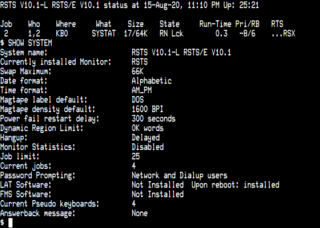
RSTS is a multi-user time-sharing operating system developed by Digital Equipment Corporation for the PDP-11 series of 16-bit minicomputers. The first version of RSTS was implemented in 1970 by DEC software engineers that developed the TSS-8 time-sharing operating system for the PDP-8. The last version of RSTS was released in September 1992. RSTS-11 and RSTS/E are usually referred to just as "RSTS" and this article will generally use the shorter form. RSTS-11 supports the BASIC programming language, an extended version called BASIC-PLUS, developed under contract by Evans Griffiths & Hart of Boston. Starting with RSTS/E version 5B, DEC added support for additional programming languages by emulating the execution environment of the RT-11 and RSX-11 operating systems.
TOPS-10 System is a discontinued operating system from Digital Equipment Corporation (DEC) for the PDP-10 mainframe computer family. Launched in 1967, TOPS-10 evolved from the earlier "Monitor" software for the PDP-6 and PDP-10 computers; this was renamed to TOPS-10 in 1970.
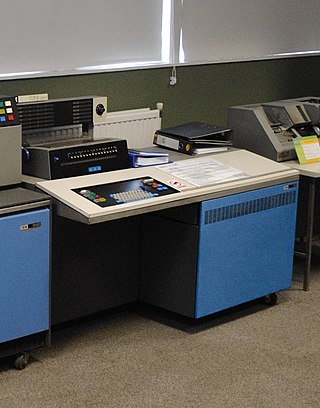
The IBM 1130 Computing System, introduced in 1965, was IBM's least expensive computer at that time. A binary 16-bit machine, it was marketed to price-sensitive, computing-intensive technical markets, like education and engineering, succeeding the decimal IBM 1620 in that market segment. Typical installations included a 1 megabyte disk drive that stored the operating system, compilers and object programs, with program source generated and maintained on punched cards. Fortran was the most common programming language used, but several others, including APL, were available.
DIBOL or Digital's Business Oriented Language is a general-purpose, procedural, imperative programming language that was designed for use in Management Information Systems (MIS) software development. It was developed from 1970 to 1993.

A COM file is a type of simple executable file. On the Digital Equipment Corporation (DEC) VAX operating systems of the 1970s, .COM was used as a filename extension for text files containing commands to be issued to the operating system. With the introduction of Digital Research's CP/M, the type of files commonly associated with COM extension changed to that of executable files. This convention was later carried over to DOS. Even when complemented by the more general EXE file format for executables, the compact COM files remained viable and frequently used under DOS.
FOCAL is an interactive interpreted programming language based on JOSS and mostly used on Digital Equipment Corporation (DEC) Programmed Data Processor (PDP) series machines.
VSI BASIC for OpenVMS is the latest name for a dialect of the BASIC programming language created by Digital Equipment Corporation (DEC) and now owned by VMS Software Incorporated (VSI). It was originally developed as BASIC-PLUS in the 1970s for the RSTS-11 operating system on the PDP-11 minicomputer. It was later ported to OpenVMS, first on VAX, then Alpha, and most recently Integrity.
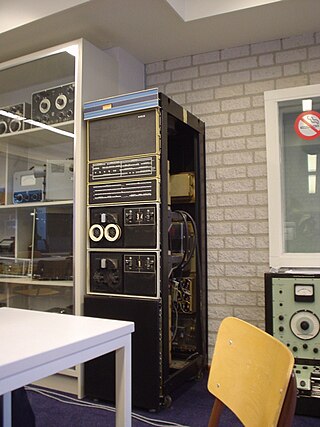
The PDP-15 was the fifth and last of the 18-bit minicomputers produced by Digital Equipment Corporation. The PDP-1 was first delivered in December 1959 and the first PDP-15 was delivered in February 1970. More than 400 of these successors to the PDP-9 were ordered within the first eight months.
On-line Debugging Tool (ODT) is a family of several debugger programs developed for Digital Equipment Corporation (DEC) hardware. Various operating systems including OS/8, RT-11, RSX-11, and RSTS/E implement ODT, as did the firmware console of all of the LSI-11-family processors including the 11/03, 11/23/24, 11/53, 11/73, and 11/83/84.
BATCH-11/DOS-11, also known simply as DOS-11, is a discontinued operating system by Digital Equipment Corporation (DEC) of Maynard, Massachusetts. The first version of DOS-11 (V08-02) was released in 1970 and was the first operating system to run on the Digital PDP-11 minicomputer. DOS-11 was not known to be easy to use even in its day and became much less used in 1973 with the release of the RT-11 operating system.
TSS/8 is a discontinued time-sharing operating system co-written by Don Witcraft and John Everett at Digital Equipment Corporation in 1967. DEC also referred to it as Timeshared-8 and later the EduSystem 50.
In computer programming, a function, subprogram, procedure, method, routine or subroutine is a callable unit that has a well-defined behavior and can be invoked by other software units to exhibit that behavior.
The OS/360 Object File Format is the standard object module file format for the IBM DOS/360, OS/360 and VM/370, Univac VS/9, and Fujitsu BS2000 mainframe operating systems. In the 1990s, the format was given an extension with the XSD-type record for the MVS Operating System to support longer module names in the C Programming Language. This format is still in use by the z/VSE operating system. In contrast, it has been superseded by the GOFF file format on the MVS Operating System and on the z/VM Operating System. Since the MVS and z/VM loaders will still handle this older format, some compilers have chosen to continue to produce this format instead of the newer GOFF format.
The GOFF specification was developed for IBM's MVS operating system to supersede the IBM OS/360 Object File Format to compensate for weaknesses in the older format.
References
- 1 2 "Concise Command Language" (CCL). "OS/8 Handbook" (PDF). Digital Equipment Corporation. April 1974. Retrieved 1 May 2024.
- 1 2 Peter Clark (July 1982). "DEC TIMESHARING (1965)". The DEC Professional. p. 34.